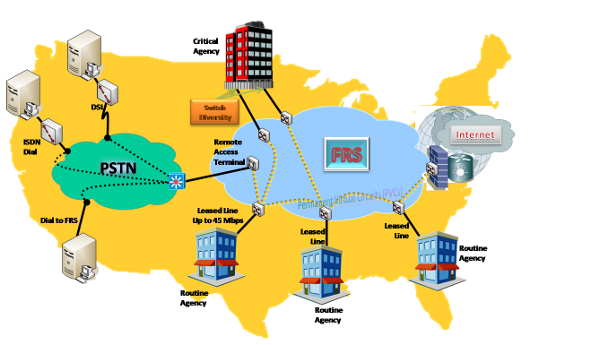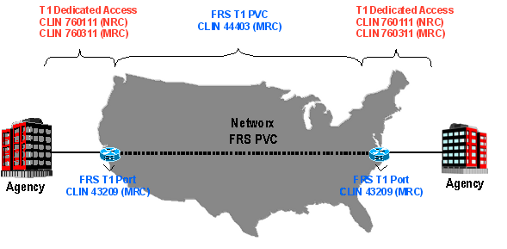Frame Relay Service (FRS) provides reliable, connection-oriented data transmission between user locations at service levels that are determined by the customer. Networx FRS provides service continuity to FTS2001 contracts, covering CONUS, OCONUS, and some Non-Domestic locations. The service's flexibility and built-in secure reliability make it an attractive alternative to private line networks.
The example shown below illustrates some of the key technical requirements provided by FRS. Agencies with both Routine and Critical Service Level Agreements (SLAs) are connected to the contractor's backbone network through contractor-provided access services that include dial-up Integrated Services Digital Network (ISDN), Digital Subscriber Line (DSL), Ethernet, high speed cable, Asynchronous Transfer Mode Service (ATMS), Private Line Service (PLS), other Agency FRS, and dial-backup. FRS will connect customer locations via customer's routers, layer 2/3 switches, multiplexing/switching devices, computers, and other Frame Relay Access Devices (FRADs).

The Networx FRS solution provides connection-oriented, data transmission at data rates up to DS3. An Agency purchases bandwidth by specifying the Committed Information Rate (CIR), which is the Agency's guaranteed minimum transmission rate for a Permanent Virtual Circuit (PVC). FRS enables bursting above the CIR up to the capacity of the access circuits. In addition, FRS provides E-1 and E-3 port speeds for terminations outside the United States.
FRS supports the following technical capabilities as described in Section C.2.3.1.1.4 of the Networx contracts:FRS allows Agencies to interconnect sites served by ATMS, FRS, PLS, and Ethernet services. The Multiprotocol Label Switching (MPLS) backbone creates virtual circuits between MPLS-enabled endpoints on the network and Agencies will receive customized FRS solutions that meet the Agency's specific requirements.
FRS features are available that include:
These features are described in more detail in Section C.2.3.1.2.1 of the Networx contracts.
Each Networx contractor may provide variations or alternatives to the offering and pricing for FRS. The specific details can be found within each contractor's Networx contract files and pricing notes for FRS.
For more information on the general FRS specifications and requirements, please refer to Section C.2.3.1 of the Networx contracts for technical specifications and Section B.2.3.1 for pricing.
FRS provides connection-oriented data transmission, between user locations, at contracted service levels up to DS3. Permanent Virtual Circuits (PVCs) are distinguished by simplex versus duplex and by frame rate type:
FRS is similar to the FR Service offered on FTS2001 contracts.
Price components required for full end-to-end service for CONUS, OCONUS, and Non-Domestic FRS:
* Some or all price components are priced on an Individual Case Basis (ICB). CLINs with ICB prices are not available in the unit pricer.
Example 1: FRS CONUS T1

Each Networx contractor may provide variations or alternatives to the offering and pricing for FRS. The specific details can be found within each of the Networx contract files and pricing notes for FRS.
For more information on the general FRS specifications and requirements, please refer to Section C.2.3.1 of the Networx contract for technical specifications and Section B.2.3.1 for pricing.